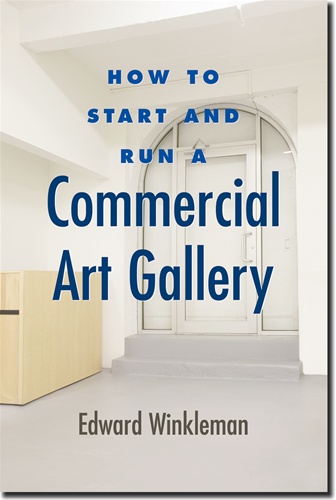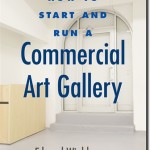BOOK REVIEW: HOW TO START AND RUN A COMMERCIAL ART GALLERY
There are few in the world who have spent more time and effort de-mystifying the commercial art gallery, and educating artists and collectors about what happens in the usually opaque world of art sales, than Edward Winkleman. As owner of his own eponymous Chelsea gallery, and author of a widely read and discussed blog, he is known for his honesty and candor when discussing the art business, and frequently offers some great and blunt advice for artists looking to sell their work through commercial galleries.
It was based on my respect for his writing, and work as a gallerist that prompted me to pick up his latest book How To Start And Run A Commercial Art Gallery, rather than out of any interest I might have in starting a gallery. Winkleman has never approached his writing or job as a gallerist in a conventional way, and I figured that his book would be unconventional as well.
Right away, while still in the Introduction, it becomes obvious that the book is mis-titled and should be read by a much broader audience than the handful of people currently considering starting a gallery. On one hand, anyone starting a small business -- especially one that deals in a "product" as unstable as art -- will learn a lot about how to set up, finance, brand and promote themselves. Winkleman covers all the basics quickly and cleanly, from the mission statement and business plan to the selection of a space and how to create a brand, all of which is useful information for anyone looking to create their own market, which certainly includes artists.
The other audience who Winkleman seeks to benefit are those who wish to understand what a galleries are, how they function, and why they do things a certain way. For most artists, this is an essential part of finding and working with a gallery. Here, Winkleman's history as a blogger shines through, as he cleanly describes the gallery business in a way that accommodates both the commonplace aspects of art galleries (opening receptions, white walls, promotion) with the wildly subjective and individualist nature of the business. This includes a range of topics from whether a gallery should be cold and modern feeling or warm and inviting to why one would name the gallery after themselves as opposed to dreaming up a wild, provocative name. Throughout, his tone is casual, almost conversational, as if he is sharing with a friend the wisdom gained over time and that, since you asked, he doesn't mind sharing. For those who follow the art world closely, he also plays the fun game of telling stories that feature "a certain dealer I know" or "a secondary market dealer I am friends with" that make one feel as if they are getting some insider gossip.
How To Start And Run A Commercial Art Gallery is incredibly readable and, thankfully, structured in such a way that the different audiences can read it in different ways. For those who need an actual handbook for starting a gallery, it is structured to take one through the process, and breaks down the various steps into understandable and accessible sections. For those looking to understand how a gallery works without actually starting a white cube of their own, Winkleman keeps things moving with stories of the successes and failures of both his own and other galleries, along with interviews, quotes and historical examples that tell a tale of a business that has deep and complicated roots, but is home to a number of unique personalities who are always innovating. He goes out of his way, in almost every chapter, to remind readers that while the art world may have its conventions, there is always someone who might come along and have success by breaking the rules.
On his blog, Winkleman promoted the book with a quote from the introduction, which sums up both the style and intent of his book nicely:
Introduction: The Easy Part and the Hard Part
Shortly after moving to New York City, I met a producer of off-Broadway plays at a party. Listening to him describe his passion, I grew highly impressed with his resilience in finding backers for his productions. He said he wouldn't even begin to become discouraged until the thirteenth potential investor turned him down. In fact, he took anything other than a flat-out "No!" as encouragement, and he rarely accepted the first "No!" as a final answer, anyway. Nothing was going to dissuade him from following his dream.
I was busy soaking up these insights, so I was caught by surprise when he asked what I was doing in New York. What was my dream, he wanted to know.
"I'd like to open an art gallery," I answered.
"That's great," he replied. "How are you going about doing that?"
"Er...uh...well," I said. "I'm doing studio visits with lots of artists, and working freelance for a gallery, and attending art fairs, and...."
"That's the lamest thing I've ever heard," he interjected.
"Excuse me?" I asked, visibly offended.
"What is an art gallery?" he continued. "It's a space with art on the walls. If you want to open an art gallery, get a space and put art on the walls."
"Wait...er...it's not that simple," I insisted.
"Yes it is," he insisted. "It's exactly that simple. Get a space, put art on the walls, and you will have an art gallery."
He was right of course. It was that simple. Six months after that conversation, I rented a space on the Lower East Side for a weekend, put art on the walls, and had my first (if highly temporary) art gallery. I even sold some work. What the producer-mentor didn't tell me back then, though, was that finding a space and putting art on the walls is the easy part. Staying in business is the real trick.
How To Start And Run A Commercial Art Gallery is one of those rare books that is simultaneously factual, fun to read, and useful beyond the seemingly narrow audience its title would suggest. Anyone who wants to understand the complex (and often idiosyncratic) nature of the art business, as well as anyone who thinks they can innovate on the current model, should spend some time with this book.
- Edward Winkleman
Winkleman Gallery
Edward Winkleman's blog
Here is a great Bad At Sports interview with Edward Winkleman
You can buy a copy of "How To Start And Run A Commercial Art Gallery" here.
Book cover image via Edward Winkleman's blog. Winkleman image via Facebook.





